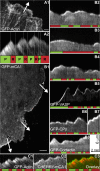Capping protein regulatory cycle driven by CARMIL and V-1 may promote actin network assembly at protruding edges
- PMID: 24778263
- PMCID: PMC4024869
- DOI: 10.1073/pnas.1313738111
Capping protein regulatory cycle driven by CARMIL and V-1 may promote actin network assembly at protruding edges
Abstract
Although capping protein (CP) terminates actin filament elongation, it promotes Arp2/3-dependent actin network assembly and accelerates actin-based motility both in vitro and in vivo. In vitro, capping protein Arp2/3 myosin I linker (CARMIL) antagonizes CP by reducing its affinity for the barbed end and by uncapping CP-capped filaments, whereas the protein V-1/myotrophin sequesters CP in an inactive complex. Previous work showed that CARMIL can readily retrieve CP from the CP:V-1 complex, thereby converting inactive CP into a version with moderate affinity for the barbed end. Here we further clarify the mechanism of this exchange reaction, and we demonstrate that the CP:CARMIL complex created by complex exchange slows the rate of barbed-end elongation by rapidly associating with, and dissociating from, the barbed end. Importantly, the cellular concentrations of V-1 and CP determined here argue that most CP is sequestered by V-1 at steady state in vivo. Finally, we show that CARMIL is recruited to the plasma membrane and only at cell edges undergoing active protrusion. Assuming that CARMIL is active only at this location, our data argue that a large pool of freely diffusing, inactive CP (CP:V-1) feeds, via CARMIL-driven complex exchange, the formation of weak-capping complexes (CP:CARMIL) at the plasma membrane of protruding edges. In vivo, therefore, CARMIL should promote Arp2/3-dependent actin network assembly at the leading edge by promoting barbed-end capping there.
Keywords: VASP; cell migration.
Conflict of interest statement
The authors declare no conflict of interest.
Figures









Similar articles
-
Reconstitution of Arp2/3-nucleated actin assembly with proteins CP, V-1, and CARMIL.Curr Biol. 2024 Nov 18;34(22):5173-5186.e4. doi: 10.1016/j.cub.2024.09.051. Epub 2024 Oct 21. Curr Biol. 2024. PMID: 39437783
-
Mechanism for CARMIL protein inhibition of heterodimeric actin-capping protein.J Biol Chem. 2012 May 4;287(19):15251-62. doi: 10.1074/jbc.M112.345447. Epub 2012 Mar 12. J Biol Chem. 2012. PMID: 22411988 Free PMC article.
-
Two distinct mechanisms for actin capping protein regulation--steric and allosteric inhibition.PLoS Biol. 2010 Jul 6;8(7):e1000416. doi: 10.1371/journal.pbio.1000416. PLoS Biol. 2010. PMID: 20625546 Free PMC article.
-
Capping protein regulators fine-tune actin assembly dynamics.Nat Rev Mol Cell Biol. 2014 Oct;15(10):677-89. doi: 10.1038/nrm3869. Epub 2014 Sep 10. Nat Rev Mol Cell Biol. 2014. PMID: 25207437 Free PMC article. Review.
-
New insights into mechanism and regulation of actin capping protein.Int Rev Cell Mol Biol. 2008;267:183-206. doi: 10.1016/S1937-6448(08)00604-7. Int Rev Cell Mol Biol. 2008. PMID: 18544499 Free PMC article. Review.
Cited by
-
Function and regulation of the Arp2/3 complex during cell migration in diverse environments.Curr Opin Cell Biol. 2016 Oct;42:63-72. doi: 10.1016/j.ceb.2016.04.005. Epub 2016 May 8. Curr Opin Cell Biol. 2016. PMID: 27164504 Free PMC article. Review.
-
ELMO1 Directly Interacts with Gβγ Subunit to Transduce GPCR Signaling to Rac1 Activation in Chemotaxis.J Cancer. 2016 May 12;7(8):973-83. doi: 10.7150/jca.15118. eCollection 2016. J Cancer. 2016. PMID: 27313788 Free PMC article.
-
Latrunculin A Accelerates Actin Filament Depolymerization in Addition to Sequestering Actin Monomers.Curr Biol. 2018 Oct 8;28(19):3183-3192.e2. doi: 10.1016/j.cub.2018.07.082. Epub 2018 Sep 27. Curr Biol. 2018. PMID: 30270183 Free PMC article.
-
A human immunodeficiency syndrome caused by mutations in CARMIL2.Nat Commun. 2017 Jan 23;8:14209. doi: 10.1038/ncomms14209. Nat Commun. 2017. PMID: 28112205 Free PMC article.
-
Twinfilin is a nonprocessive depolymerase which synergizes with formin to dramatically accelerate actin filament uncapping by 300-fold.Proc Natl Acad Sci U S A. 2025 May 6;122(18):e2501078122. doi: 10.1073/pnas.2501078122. Epub 2025 Apr 28. Proc Natl Acad Sci U S A. 2025. PMID: 40294253
References
-
- Pollard TD, Borisy GG. Cellular motility driven by assembly and disassembly of actin filaments. Cell. 2003;112(4):453–465. - PubMed
-
- Chhabra ES, Higgs HN. The many faces of actin: Matching assembly factors with cellular structures. Nat Cell Biol. 2007;9(10):1110–1121. - PubMed
-
- Loisel TP, Boujemaa R, Pantaloni D, Carlier MF. Reconstitution of actin-based motility of Listeria and Shigella using pure proteins. Nature. 1999;401(6753):613–616. - PubMed
MeSH terms
Substances
LinkOut - more resources
Full Text Sources
Other Literature Sources
Molecular Biology Databases
Miscellaneous

